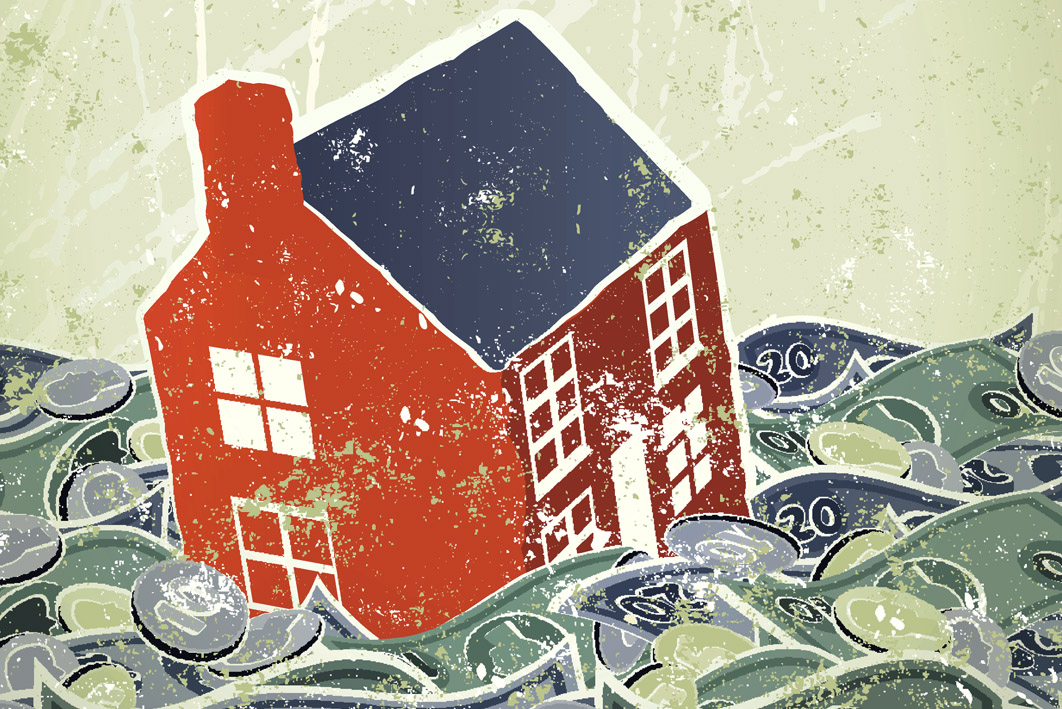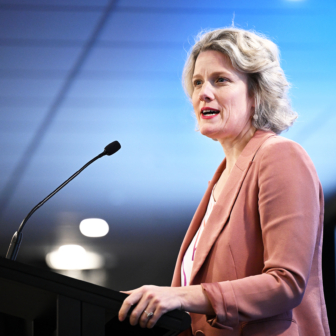When I came to Melbourne to take up a short-term job with the ABC in December 1986, I moved into a rented house in the beachside suburb of St Kilda. I met my housemates for the first time when I walked tentatively up the front path, bicycle and backpack in tow. It was Carolyn who greeted me at the door. With a beaming smile, she insisted we immediately go out for breakfast on nearby Fitzroy Street. We’ve been friends ever since.
There were seven of us in that neglected Federation-era terrace, four adults and three children, including Carolyn’s two preschool-aged boys. It was chaotic and highly sociable and I loved the place — which I’d assumed would be a temporary home — from day one. When my ABC job became permanent, I gladly stayed on.
I had the front bedroom on the second floor, which was meant to give me, as the only non-parent, a bit of extra distance from the trio of exuberant children. We shopped in bulk at South Melbourne market and endeavoured to grow veggies in the backyard. There was always someone cooking or eating in the kitchen and the overflowing compost bin invariably needed emptying.
A constant stream of visitors would call by unannounced — this was before mobile phones — and I entered the social circle that led me to Julie, my partner now for more than thirty years. Like many group houses, though, it didn’t last, and after two years Carolyn and I looked for a new place. We were compatible housemates, and I enjoyed sharing my life with her boys, who were now at school.
For the next two years, the four of us lived in a single-fronted brick terrace in East St Kilda. It was dark, damp and cold in winter, with only a dodgy gas fire in the lounge room for heating, but there were parks, playgrounds and a swimming pool nearby, and on sunny mornings the east-facing kitchen would fill with light.
By 1990, I had been living in shared rental houses for more than a decade. At times, I imagined — naively, idealistically — that this would be how I would always live. I still got on well with Carolyn and her boys, but I had a full-on job and hankered for more orderly surroundings.
After four years at the ABC I had some savings, which my mother had just topped up with ten thousand dollars, generously sharing part of her retirement package with her four children. Julie already owned a house with a friend — she had supplemented her modest wages by making junk jewellery to sell at weekend markets in order to scratch together her original deposit (at a time when banks often demanded that women have a man to act as guarantor on their loan application) — and she understood the real estate market.
So, with Julie’s help, I started looking around for a flat to buy. In the process of inspecting properties, we realised that we really wanted to move in together. With assets and jobs, we had little trouble getting a mortgage on a modest weatherboard in Northcote, though at the time $80,000 seemed a frighteningly large sum to borrow, especially at 15.5 per cent interest.
Julie and I sold that Northcote house three years later, and since then we have bought and sold two other houses in inner Melbourne, realising a significant increase in value each time. The last one was in St Kilda, not far from where Carolyn and I used to share a house. We bought it in 1999, and Carolyn, who still lived nearby, came along to cheer for us at the Saturday morning auction.
It was lucky she did, because I’d forgotten our chequebook, and when we surprised ourselves by ending up as top bidders, we couldn’t complete the contract. Carolyn gallantly dashed home to get her own chequebook and wrote out a cheque for a deposit of tens of thousands of dollars drawn on her own account. We all thought this was pretty funny, Carolyn especially, since she had no savings. On the following Monday, we replaced her deposit with our own and gave Carolyn back her cheque — as a joke, she kept it on her pin board.
Recalling the story now, the humour of the situation has a darker edge to it. In the twenty-seven years since Carolyn and I last shared a house, she has lived in at least a dozen different rental properties. Julie and I have chosen our real estate well, mostly thanks to her nous in picking houses that were undervalued, and we have worked hard to maintain and improve the properties we have owned — investing our money and our sweat in renovations, sanding floors, patching holes, painting ceilings and landscaping gardens.
According to philosopher John Locke’s theory about the origins of private property, Julie and I have been “industrious and rational” and deserve the wealth that has come our way. In truth, though, like most other people who were able to buy houses a decade or more ago, we mostly benefited from a large dose of generational circumstance and locational luck. On relatively modest salaries, we were able to buy houses in inner- and middle-ring suburbs that have dramatically increased in value. By contrast, Carolyn, equally rational and industrious, has been punished for renting — or rather, despite a lifetime of hard work and self-reliance, she has been punished for having neither secure employment nor parents affluent enough to help her out with a gift or an inheritance.
“If I’d had a decent secure income or a big inheritance, we wouldn’t be having this conversation,” says Carolyn, when we discuss our different housing trajectories over the past three decades. Today we are both in our mid-fifties, and Carolyn knows the demographic reality: older renters on low incomes are at increasing risk of homelessness. While only about 6 per cent of over sixty-fives live in private rental housing, their situation points to a dark cloud on the not-so-distant horizon — falling home-ownership rates mean more people are now entering retirement (or continuing in casual, low-paid, insecure jobs) without owning a home. With few assets and a low income, often just the age pension, it is challenging to find an affordable place to live. Already, seven out of ten older renters live in “stress,” which means they shell out more than 30 per cent of their income to the landlord, and potentially scrimp on essentials like food, heating and healthcare.
There are likely to be more older women than older men in this vulnerable category, because women live longer and need more money to adequately fund their later years, but generally leave work with fewer assets. Signs of the problem are already evident. The number of women aged over sixty-five living in private rental housing grew by 64 per cent between 2006 and 2016. In 2016–17, for the first time since the Australian Institute of Health and Welfare began collecting the data, the number of women presenting as homeless overtook the number of men. In 2017, Homelessness Australia found that the number of women over fifty who were couch surfing had almost doubled in the previous four years.
Carolyn is not couch surfing, but she is part of this at-risk cohort. In a decade from now, when she is sixty-five years old, she will probably still have a low income and not much superannuation, and she will almost certainly still be paying rent to a private landlord.
When we meet at her place for breakfast, Carolyn has to come down and let me in at the “security gate.” She should be able to buzz me in from upstairs, but the remote-release lock is perpetually broken. Often there is no security at all, because whenever it rains the wooden gate swells up and won’t close.
Carolyn lives on the top floor of a three-storey block of fifteen red-brick, sixties-era, walk-up flats. With a vista across the rooftops of Victorian terraces to the Exhibition gardens, she reckons she has one of the best views in Melbourne, but her apartment has no heating or cooling, so the temperature inside depends heavily on the weather outside. On hot summer days, Carolyn uses sheets of cardboard to block the rays of the sun penetrating the thin window glass.
There is no exhaust fan in the bathroom or the kitchen, which is barely a kitchen in any case because it does not have an oven or a stove. Carolyn does all her cooking on a single plug-in electric hotplate, which she uses to fire up the espresso pot and warm us some croissants. She has become adept at one-pot meals, generally soups and stews that will last her for a couple of days, supplemented by salad, including lettuces grown on her window sill. She has managed to squeeze in a small couch alongside the table and chairs where we sit for breakfast; it doubles as a bed for her eldest grandchild when he has a sleepover. At $285 a week, she reckons she has found the cheapest one-bedroom flat in inner Melbourne, but rent still chews up close to 40 per cent of her income. Carolyn is not grumbling. “It’s a kooky little flat,” she says, “but I love it.”
Everyone, renters and property owners alike, wants to turn the place they live in into a home. At her own expense, Carolyn is gradually repainting the entire flat to make it cleaner and lighter. It looks like it has been a long time since this was last done, and while redecoration and maintenance are technically the landlord’s responsibility, Carolyn has repainted at least one room in almost every place she has rented.
She has also installed a curtain on the entrance to the bathroom because the sliding door is stuck and she does not see much point in asking the landlord to fix it. “I got the toilet fixed because it had a leaking pipe,” she says. “But the pipe still leaks and now the toilet won’t stop flushing.” The kitchen cupboard over her benchtop has a lean on it to rival the Tower of Pisa, jutting out from the wall at a disconcerting angle. Carolyn had that fixed, too, but rather than securing the cupboard back flat against the wall, the handyman simply braced it with a couple of extra bolts to stop it pulling away any further.
According to estimates on real estate websites, the modest Northcote weatherboard house that Julie and I bought for $137,500 in 1990 is now worth between $1.7 and $2.2 million. Most of the price rise derives not from the improvements that we, or any subsequent owners, made to the property, but from the underlying increase in the value of the land. Changes in the structure of the economy and the labour market have made city centres the locus of high-income jobs. While property prices have risen across the board, the increase has been steepest in inner suburbs, especially in places with good public transport links, parks, shops and desirable schools.
Carolyn’s boys are now in their thirties, and both of them have been in good, secure, full-time jobs for many years. Both rent, and Carolyn knows she will never be able to help them to buy their own homes. By contrast, Julie and I can afford to act as family bankers for our son, and when we die, he will inherit whatever property wealth we have left. In this way, the real estate market entrenches inequality.
Julie and I may move again one day, but we will control the when and the where. Carolyn enjoys no such security and may soon be forced to find a new place to rent. The Fitzroy block containing her kooky little flat recently went on the market. Chances are it will be demolished to make way for luxury apartments. Plenty of people would pay a lot of money for Carolyn’s fine view. •
This is an edited extract from No Place Like Home: Repairing Australia’s Housing Crisis, released this week by Text Publishing.




